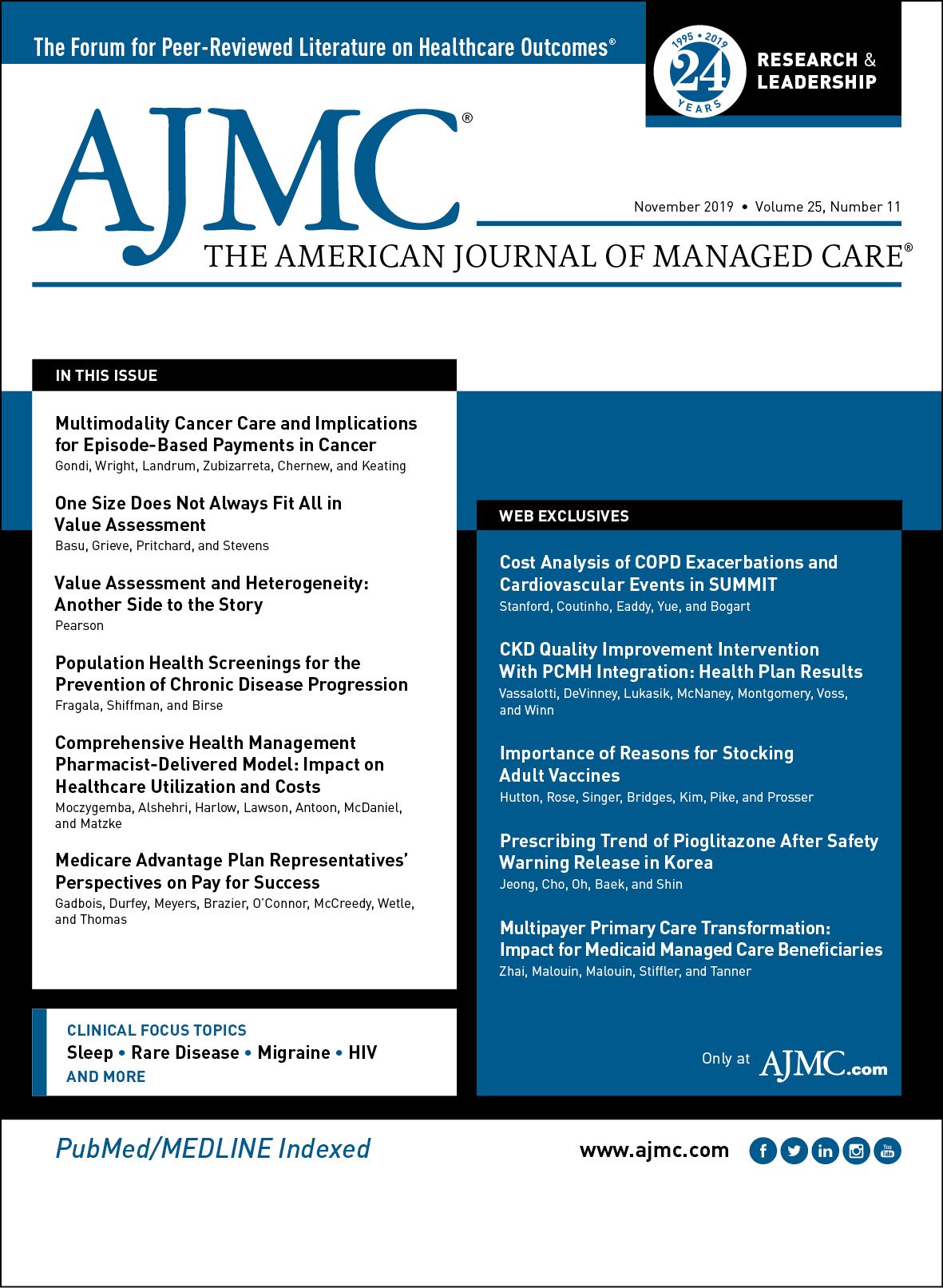- Center on Health Equity & Access
- Clinical
- Health Care Cost
- Health Care Delivery
- Insurance
- Policy
- Technology
- Value-Based Care
From the Editorial Board: Joshua J. Ofman, MD, MSHS
Few diagnoses strike more fear than cancer. My family members have personally been touched by both fatal cancer and early cancer caught at a curable stage, as well as a “scare” that fortunately turned out to be benign. I know the fear of cancer that keeps people up at night. Despite treatment advances, cancer still takes an overwhelming human toll: It is the second leading cause of death globally. Why? In large part, because we diagnose most cancers too late. Today, screening is only recommended by the US Preventive Services Task Force (USPSTF) for colon, breast, lung (in smokers), and cervical cancers. Most other cancer diagnoses are made when signs or symptoms appear, often when cancer has already metastasized.
Indeed, the 5-year cancer-specific survival is nearly 325% better among those diagnosed with localized disease than with distant metastases. Moreover,1 treatment of metastatic cancer is up to 2 times more costly than for nonmetastatic cancer.2,3 Even a modest 1% reduction in cancer mortality is projected to deliver $695 billion in economic value to society.4
By projecting current USPSTF screening recommendations onto the US population aged 50 to 79 years at historical compliance rates, approximately 9 million positive tests would be generated and 151,000 cancers detected—a true-positive to false-positive ratio of 1:60. The high false-positive rates and detection of potentially nonlethal cancers (overdiagnosis) are some of the reasons that recommendations differ and debate continues.5-8
Clearly, something needs to change.
We are at an unprecedented time, when the genomic revolution is driving insights into cancer biology, detection, prognosis, and management. New treatments are agnostic to tumor type, focusing on specific mutations shared by different cancers. Advances in next-generation sequencing and machine learning have enabled detection and sequencing of highly specific cancer-derived DNA signals in blood. Identification of methylation patterns in DNA has been shown to be a superior mechanism for cancer signal detection than looking for mutations or somatic copy number alterations.9
What if we could leverage this transformational technology and add to current screening with a blood test that could detect multiple deadly cancers, with a combined false-positive rate of less than 1%? Such a test could detect 3 times more cancers (~460,000) and do so much more efficiently, with a true-positive to false-positive ratio of only 1:2.4.9
How do we get there? Recent reports of blood-based approaches show that detecting multiple cancers is possible at high specificity.9-11 To get these to the clinic, it will be important for stakeholders—policy makers, payers, healthcare providers, and patients—to shift their thinking around what is possible and to help ensure that there are mechanisms in place to provide access to this innovative technology to detect cancer early, when treatments are most effective.
This approach has the potential to address an enormous unmet medical need. There remains work to do to understand how a blood-based approach to early detection will work in actual practice and to evaluate patient and provider acceptance. But the promise is clear: Detecting cancer at earlier stages should translate into improved outcomes, reduced harms from unnecessary work-ups, and potentially lower costs—which could allow everyone to sleep better at night.
Dr Ofman works for GRAIL, Inc.
REFERENCES
1. SEER*Stat databases: November 2018 submission: incidence - SEER 18 regs research data, Nov 2018 sub. Surveillance, Epidemiology, and End Results Program website. seer.cancer.gov/data-software/documentation/seerstat/nov2018. Accessed October 8, 2019.
2. Banegas MP, Yabroff KR, O’Keeffe-Rosetti MC, et al. Medical care costs associated with cancer in integrated delivery systems. J Natl Compr Canc Netw. 2018;16(4):402-410. doi: 10.6004/jnccn.2017.7065.
3. DaCosta Byfield S, Nash Smyth E, Mytelka D, Bowman L, Teitelbaum A. Healthcare cost, treatment patterns, and resource utilization among pancreatic cancer patients in a managed care population. J Med Econ. 2013;16(12):1379-1386. doi: 10.3111/13696998.2013.848208.
4. Murphy KM, Topel RH. The value of health and longevity [NBER working paper no. 11405]. National Bureau of Economic Research website. nber.org/papers/w11405. Published June 2005. Accessed October 8, 2019.
5. Welch HG, Kramer BS, Black WC. Epidemiologic signatures in cancer. N Engl J Med. 2019;381(14):1378-1386. doi: 10.1056/NEJMsr1905447.
6. Davies L, Petitti DB, Woo M, Lin JS. Defining, estimating, and communicating overdiagnosis in cancer screening. Ann Intern Med. 2018;169(11):824. doi: 10.7326/L18-0517.
7. Hoffman KE, Nguyen PL. The debate over prostate cancer screening guidelines. Virtual Mentor. 2011;13(1):10-15.
8. Kelly T. The screening debate—affirmative: cuts cancer mortality, negative: there’s no hard proof. Managed Care website. managedcaremag.com/archives/2017/5/screening-debate-affirmative-cuts-cancer-mortality-negative-there-s-no-hard-proof. Published May 3, 2017. Accessed October 8, 2019.
9. Liu MC, Jamshidi A, Venn O, et al. Genome-wide cell-free DNA (cfDNA) methylation signatures and effect on tissue of origin (TOO) performance. J Clin Oncol. 2019;37(15 suppl):3049. doi: 10.1200/JCO.2019.37.15_suppl.3049.
10. Oxnard GR, Klein EA, Seiden MV, et al. Simultaneous multi-cancer detection and tissue of origin (TOO) localization using targeted bisulfite sequencing of plasma cell-free DNA (cfDNA). J Glob Oncol. 2019;5(suppl 1). Abstract 44.
11. Cohen JD, Li L, Wang Y, et al. Detection and localization of surgically resectable cancers with a multi-analyte blood test. Science. 2018;359(6378):926-930. doi: 10.1126/science.aar3247.

Trends in Hospital Pricing for Vulnerable Emergency Department Users, 2021-2023
December 4th 2025Self-pay emergency department prices rose significantly from 2021 to 2023, especially at for-profit and system-affiliated hospitals, highlighting growing affordability challenges for uninsured and underinsured patients.
Read More
Integrated Care for Chronic Conditions: A Randomized Care Management Trial
December 3rd 2025The authors sought to understand the differential impact of payer-led community-based care management approaches on stakeholder-oriented outcomes for publicly insured adults with multiple chronic conditions.
Read More

